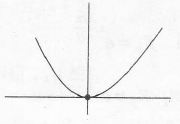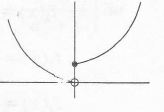Answer:
Option D
Explanation:
(P) Plan
(i) For such questions , we need to properly define the functions and then we draw their graphs.
(ii) From the graphs,we can examine the function for continuity differentiability , one-one and onto
f1(x)={−xx<0exx≥0
f2(x)=x2,x≥0
f3(x)={sinxx<0xx≥0
f4(x)={f2(f1(x))x<0f2(f1(x))−1x≥0
Now, f2(f1(x)={x2,x<0e2x,x≥0
f4={x2,x<0e2x−1,x≥0
As f4(x) is contiinuous
f′4={2x,x<02e2x,x>0

f′4(0) is not defined
Its range is [0, ∞]
Thus, range= codomain =[0,∞] thus f4 is onto.
Also, horizontal line (drawn parallel to x-axis) meets the curve more than once function is not one-one
(Q) Plan f3(x)
differentiable at x=0 and not one-one
As evident, from the graph it is continuous and no sharp turn at X=0 , thus f(x) is differentiable at x=0

Also, a horizontal line intersects the graph more than once.
∴ It is not one-one
(R) Plan f2(f1(x))
It is neither continuous nor one-one.
From the graph , it can be observed that the function is not continuous at x=0
Also , the horizontal line intersect,the curve at more than one point So, f2(f1(x)) , is not one-one

(S) f2(x)
It is continuous and one-one
As evident from graphs , the function is continuous
also, the function is one-one , as any horizontal line will meet the graph only one

P→(i),Q→(iii),R→(ii),S→(iv)